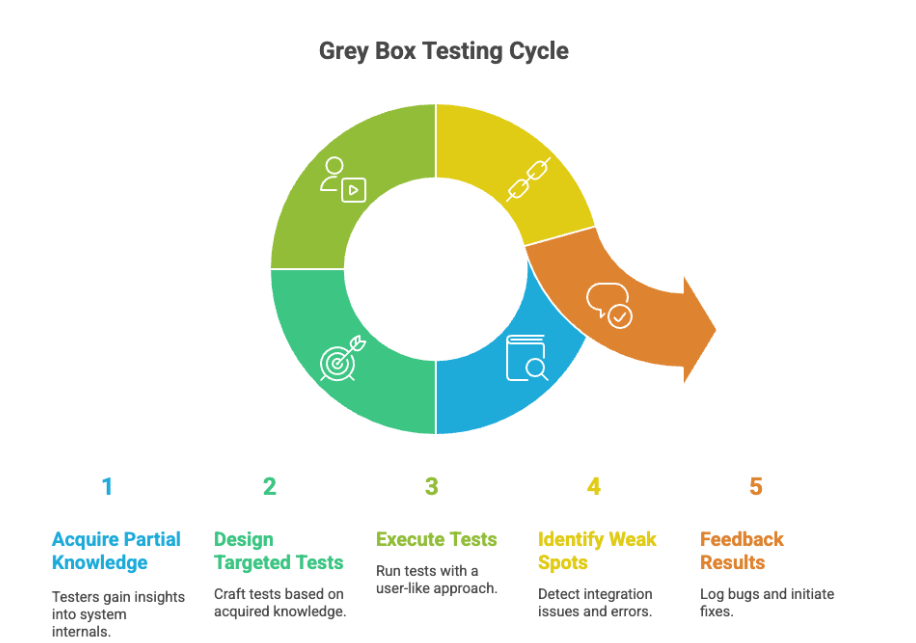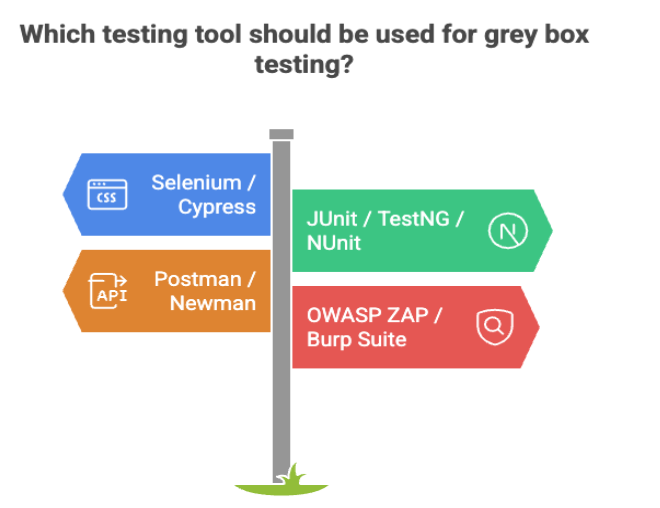Grey Box Testing Guide 2025 - What It Is, How It Works, and Benefits
You’ve seen it happen- a release goes live, and suddenly customer support lights up. The feature worked fine in staging, the unit tests were green, yet something broke once real users touched it.
Most of the time, these bugs don’t live at the surface. They hide in the middle layer- the messy space between modules, APIs, and data flows that’s rarely tested deeply enough.
It’s also an expensive problem. A NIST/IBM study highlighted that resolving defects in production can be up to 30× more expensive than fixing them during design or coding. That’s a huge gap when you multiply it across dozens of releases.
So how do you bridge that gap and test what usually slips through the cracks? That’s where Grey Box Testing comes in. Let’s dive deeper.
What Is Grey Box Testing?
Grey Box Testing is testing with partial knowledge of the system. You’re not going in blind like black box testing, and you’re not reading every function like white box. You stand somewhere in between.
Imagine looking at an app with one eye inside the system and one eye outside it. You might know the database schema, the API contracts, or how two modules interact. But you don’t need full source code access to test effectively.
That partial visibility is powerful. It lets you focus on integration points and data flows- the spots where bugs usually hide without sinking weeks into code-level analysis.
Grey Box vs Black Box vs White Box Testing
It’s easier to see where Grey Box Testing fits when you line it up against the other two approaches. Here’s a quick snapshot:
| Testing Type | What You Know | How You Test | Typical Use Cases |
|---|---|---|---|
| Black Box | Nothing about the internals | Only inputs & outputs | UI testing, end-user validation |
| White Box | Full code + architecture access | Test every path in the code | Unit testing, security audits, algorithm checks |
| Grey Box | Partial knowledge (APIs, DB schemas, design docs) | Black box style, but guided by insider info | Integration testing, data flow checks, security edge cases |
Think of it like this:
- Black box = testing as a pure outsider.
- White box = testing as the developer.
- Grey box = testing as a user who knows just enough secrets to break things smarter.
Of course, theory only goes so far. Modern QA platforms like DevAssure, an AI-agentic test orchestration platform, turn these testing practices into something teams can actually run inside CI/CD pipelines. With automation and resilience built in, grey box testing becomes more consistent across web and mobile and far less dependent on manual effort.
🚀 See how DevAssure accelerates test automation, improves coverage, and reduces QA effort.
Ready to transform your testing process?
Benefits of Grey Box Testing
Here’s why devs and testers keep grey box testing in their toolkit:
- Catches integration bugs early: Most production outages come from services not playing nice together. With partial knowledge of APIs, data flows, or configs, testers can design cases that spot those failures before users do.
- Balanced coverage without overkill: White box testing is powerful, but covering every path in a codebase can chew up weeks. Black box testing is faster, but shallow. Grey box hits the sweet spot- deep enough to find critical issues, lean enough to not slow the pipeline.
- Better security checks: Attackers often exploit the “in-between” layer- parameter tampering, broken auth, weird session handling. Grey box tests surface those risks because testers know where to poke, but don’t need full source access.
- Saves time and cost: Chasing bugs late in the cycle is expensive. Grey box testing trims that down by finding issues earlier in CI/CD, long before they hit production and support tickets start piling up.
- Realistic test scenarios: Testers think more like end users, but with insider hints. That perspective produces scenarios closer to how bugs actually happen in production and not just lab conditions.
How Does Grey Box Testing Work?
The process isn’t rocket science- it’s more about mindset than fancy tools. Here’s how teams usually roll with it:

- Get partial system knowledge: Testers aren’t digging into every line of code. Instead, they get just enough detail, maybe API docs, DB schemas, or architecture diagrams. Basically, a peek under the hood without the full source.
- Design targeted test cases: With that insider info, QA can craft smarter cases. For example, testing how a payment service behaves when an API call returns unexpected data, or how a session token behaves across services.
- Run tests like a user (but smarter): Execution still looks like black box testing on the surface — inputs and outputs but with sharper focus. Testers know where to push and what to watch.
- Spot integration weak spots: This is where the wins happen. You catch data mismatches, config errors, timing issues- the messy stuff that breaks once modules start talking to each other.
- Feed results back into the loop: Bugs get logged, fixes go into dev, and the cycle continues. Because tests are designed with context, they reduce flakiness and cover the places that usually burn teams later.
Read More: Automation Testing Guide
Common Challenges & Limitations of Grey Box Testing
Grey Box Testing sounds like the sweet spot and most of the time, it is. But like any approach, it comes with some trade-offs you should know about before betting your QA strategy on it.
- Partial knowledge can backfire.
- Hybrid skillset required.
- Deeper logic bugs might slip.
- Setup and access issues.
- Not ideal for all systems (like safety-critical industries).
Best Practices for Grey Box Testing
- Align with CI/CD early: Don’t wait until the last sprint.
- Collaborate across dev and QA: Testers need access to API contracts, DB schemas, maybe architecture notes.
- Document assumptions: Keeps debugging faster and avoids “mystery” failures.
- Automate the repetitive paths: Recurring integration tests belong in automation.
- Keep tests realistic: Blend user perspective with insider info.
Tools That Support Grey Box Testing
There isn’t a single “Grey Box Testing Tool” you can just buy off the shelf. Instead, teams mix and match what they already use.

- Selenium / Cypress: UI-driven testing with partial DOM knowledge.
- JUnit / TestNG / NUnit: Great for integration-level tests.
- Postman / Newman: Perfect for API validation when contracts are available.
- OWASP ZAP / Burp Suite: Security testing tools enhanced by insider hints.
Real-World Applications of Grey Box Testing
- Microservices and APIs: Catch contract mismatches, data type issues, or flaky timeout handling.
- Fintech and payment systems: Validate user flow and backend checks for money handling.
- Mobile apps: Test real-world sync, API dependencies, and poor connectivity scenarios.
Reading: API Testing
Where DevAssure Fits In
As an AI-agentic test orchestration platform, DevAssure makes it easier to plug grey box test cases directly into CI/CD.
With DevAssure, teams can:
- Validate APIs and catch data flow issues early
- Probe integration points across microservices
- Run cross-platform checks for web and mobile apps
- Work together in one space without endless back-and-forth
Related Reading: Low-code test automation platform
Wrapping Up: Grey Box Testing in 2025
Grey Box Testing isn’t about replacing black box or white box approaches. It’s about covering the middle ground where most modern SaaS failures actually happen.
Quick Takeaways:
- Grey box = partial knowledge, smarter testing.
- Great for APIs, fintech, and mobile ecosystems.
- Needs collaboration between dev and QA.
- Becomes stronger when tied into CI/CD with the right tools.
🚀 See how DevAssure accelerates test automation, improves coverage, and reduces QA effort.
Ready to transform your testing process?
